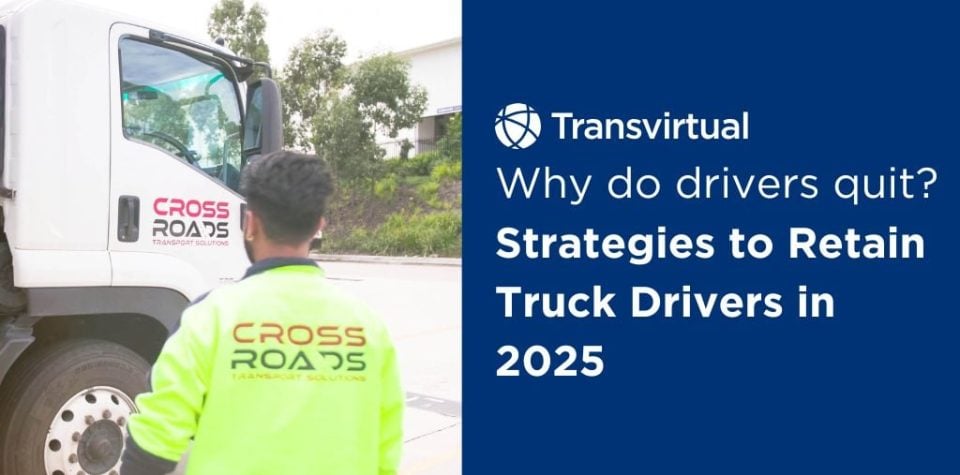Table of Contents
Truck drivers are the unsung heroes of the logistics world. They keep the wheels of commerce turning and ensure goods reach their destinations. Yet, the industry faces a growing problem: retaining qualified drivers. High turnover rates, often exceeding 90% in some sectors, disrupt operations and cost businesses significantly in recruitment and training expenses.
Each lost driver represents not only a financial hit—estimated at $5,000–$10,000 per replacement—but also a loss of experience and reliability that impacts customer satisfaction. Addressing this challenge requires understanding why drivers leave and making meaningful changes to improve their working conditions.
How can you overcome these challenges? Start by focusing on both human-centric strategies and innovative technologies to create a workplace that attracts and retains top talent.
Why Good Drivers Quit
Low Pay and Unpredictable Income
Truck drivers frequently cite pay dissatisfaction as a key reason for leaving their jobs. While drivers may earn a decent base salary, the reality of unpaid detention time at warehouses or delays due to traffic often leaves them financially shortchanged.
The American Trucking Associations estimate that detention-related delays cost the industry $1.1 billion annually, but for individual drivers, these delays can mean hours of unpaid work each week. Combined with fluctuating freight volumes, it’s no wonder drivers feel their efforts aren’t being adequately rewarded.
Work-Life Imbalance
The allure of life on the road fades quickly when drivers face weeks away from home. Long-haul trucking, in particular, can disrupt family life, leading to dissatisfaction and burnout. A survey found that over 70% of drivers consider home time a critical factor in their job decisions.
Without predictable schedules, drivers struggle to plan personal time, and prolonged absences strain relationships with loved ones, pushing them to seek alternative employment.
Interestingly, many truckers don’t actually leave the industry entirely. While some may transition into different roles within the transportation sector, such as dispatchers or fleet managers, a significant portion leave due to issues like long hours, low pay, and poor working conditions, according to the American Trucking Trends 2024 report.
Inefficient Processes and Lack of Technological Support
Many truckers leave the industry due to inefficient systems and manual processes that create roadblocks in scheduling, routing, and tracking. These inefficiencies can lead to frustration, delays, and increased stress, especially when drivers experience long wait times at loading docks or face poorly optimized routes that waste time and fuel.
Without real-time updates or streamlined communication with dispatchers, drivers often feel disconnected from the system, contributing to burnout and job dissatisfaction
Outdated or Unsafe Equipment
Equipment issues are another major frustration for drivers. Outdated trucks with poor ergonomics, frequent breakdowns, or safety hazards create unnecessary stress and delays.
A poorly maintained fleet not only reduces driver satisfaction but also impacts their safety and earning potential, leading to increased turnover.
Simple Changes That Make Drivers Stay
Transparent Pay Structures
Fair and transparent pay is critical to retaining drivers. Beyond offering competitive salaries, companies should compensate drivers for all hours worked, including waiting times and delays.
A hybrid pay structure—combining mileage pay with hourly rates—can ensure drivers are fairly rewarded while providing predictable income. Additionally, performance-based bonuses for safe driving or fuel efficiency can incentivize long-term commitment.
Leveraging Technology to Enhance Work-Life Balance
Advanced transportation management systems (TMS) and route optimization software can minimize time spent on the road, allowing drivers to get home sooner.
For instance, predictive analytics tools can account for potential delays and offer alternative routes, ensuring that drivers can stick to their schedules. Electronic logging devices (ELDs) automate compliance tracking, saving drivers the hassle of manually logging hours and reducing paperwork.
By simplifying the day-to-day operations for drivers with technology, you’ll not only enhance productivity but also improve their quality of life.
Modernizing Equipment and Maintenance
Investing in modern trucks equipped with driver-centric features can make a significant difference. Features like ergonomic seats, climate control, and smart dashboards improve comfort, while advanced telematics systems monitor vehicle health to prevent breakdowns.
Regular maintenance schedules, supported by technology, ensure that trucks remain safe and reliable, reducing downtime and frustration for drivers.
Streamlining Communication
Effective communication fosters trust and reduces misunderstandings. Mobile apps integrated with TMS platforms allow real-time updates on assignments, routes, and delays, keeping drivers informed and in control.
Clear communication also extends to addressing driver concerns. This is how you create a feedback loop where drivers can voice their opinions and see tangible results creates a sense of ownership and respect.
Recognizing and Rewarding Contributions
Simple acts of appreciation can have a big impact. Whether through monthly awards, digital shoutouts, or small tokens of gratitude, recognizing drivers’ efforts fosters a sense of belonging.
Companies can use technology to track milestones like accident-free miles or on-time deliveries, celebrating these achievements to boost morale and loyalty to your company.
The Road to Retention: Building a Driver-Centric Workplace
Drivers quit for a range of reasons, but most are rooted in solvable issues such as low pay, work-life imbalance, and outdated systems. By addressing these pain points with a mix of fair compensation, modern equipment, and technology-driven solutions, companies can significantly improve retention rates.
In an industry where driver shortages are a constant challenge, retaining good drivers isn’t just a nice-to-have—it’s what businesses need to survive. With the right changes, you will not only keep drivers but also build a reputation as an employer of choice.
Retain your top talent. Discover how Transvirtual’s solutions can help you optimize operations and create a driver-centric workplace today.



